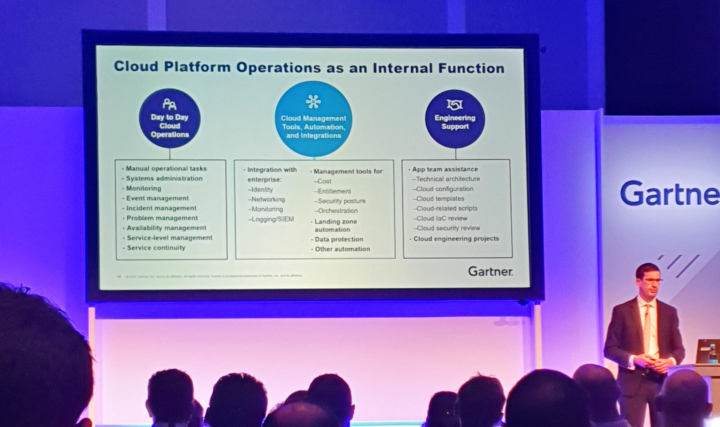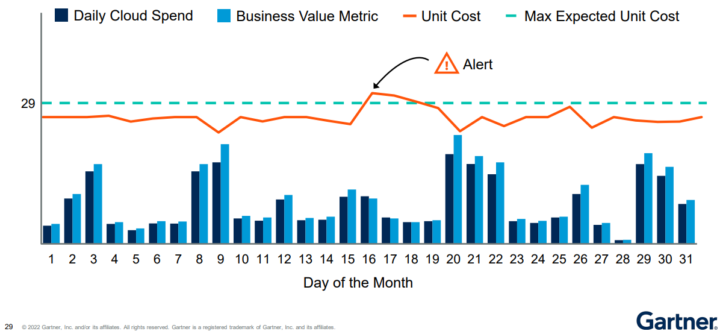
Visiting Gartner IT IOCS conference (part 3/3)
Greetings again dear reader! I hope you have enjoyed my last few posts visiting Gartner IT IOCS conference part 1 and part 2. This is the third and final part of the blog series. As mentioned in the part 2, sessions I planned to visit during the second day were as follows:
- Part 2
- The Future of Cloud: Prepare for 2027
- Kick Your Infrastructure-as-Code Journey Into High Gear
- Part 3 (THIS ARTICLE)
- Cloud Platform Operations: How to Deliver Services Like a Cloud MSP
- From Cutting Costs to Measuring the Value of Cloud Deployments
Again, in this article, I will summarize some key takeaways per session from my point of view.
Cloud Platform Operations: How to Deliver Services Like a Cloud MSP
Next session I was attending touched the topic of Cloud Platform operations in an organization as an in-house function. The role model was taken from how Cloud Managed Service Providers (MSP) are running the operations. Yes, thats like we 🙂
Cloud MSP Advantages
The main point was why is it beneficial to operate like an MSP and how to transform in-house cloud platform operations to MSP like cloud platform operations? Three key benefits were presented that make an MSP approach to Cloud platform operations attractive. They were as follows:
- Automation
- Customer-centric Mindset
- Product Management
First, automation helps to scale and therefore improves speed, quality and lowers unit costs. This can be achieved with Infrastructure-as-Code (IaC), orchestration and software engineering practises (code, test automation, CI/CD, etc.).
Second, customer-centric mindset promotes service attitude. The better service attitude, the better experience users/customers have. Also customer-centricity helps to prioritize where you need to put focus: what is important and what is not for the users or customers.
Third, product management improves professionalism. It makes service offering visible, structured and understandable. Moreover, it makes the management and delivery of the services more professional.

Adopt Cloud MSP approach
Finally, the guestion how to adopt an MSP like Cloud platform operations? To summarize, the steps to adopt the approach were as follows:
- Appoint product leadership
- Create a vision
- Recruit staff
- Launch MVP (minimum viable product)
- Iteratively improve
- Measure success
There were not any examples how organizations have succeeded in adopting an MSP like Cloud platform operations. It would have been interesting to hear success stories and also to know what size of companies and from which industries have succeeded.
Meanwhile, you can always check success stories of Cloud platform operations delivered by an actual MSP like Solita 😉 if you are interested, here are a few:
- case Terveystalo
- case Säästöpankki (in Finnish)
- case Tamro
- case Parliament of Finland
Then a short tea/coffee break and preparing for the final session.
From Cutting Costs to Measuring the Value of Cloud Deployments
Last but not least, a very insightful topic about cloud costs. Yesterday there was a session wheter Cloud is cheaper than on-prem. However, this session was about how to measure applications’ cloud spending from a value point of view instead of a cost point of view.
Cost-Centric Approach
Cost centric approach is the most popular approach. It is easy to do but it is not the best one from the business point of view. It can be even harmful if followed strictly. Few limitations that were raised were as follows:
- It focuses on optimizing the cloud resources usage
- It has fixed spend expectations (works by the way in on-premises!)
- success metrics are not optimal for digital service experience
First, if the focus is in optimizing the cloud resource usage, it may have bad effects to the performance of the applications. The best utilization by the means of resource usage may not be business wise the most optimal.
Second, if the focus is in fixed spend expectation, it may ruin the user experience. For example, think an online shop during the Black Friday. If the online shop is able to autoscale to serve all those users who want to buy from your online shop, it will mean that the costs will scale up. Then the team will get an alert “estimated budget level for this month will be exceeded, please optimize costs”. Instead, you should be happy that you have more customers than expected and scaling up is more than welcome.
Third, success metrics or KPI’s may lead you wrong. Once you only focus on the costs, you may ruin you application’s performance, availability (up-time) or even productivity.
Value Based Approach
While cost-centric approach is easy to perform, value based requires more efforts. Value based approach requires the understanding of the Unit Cost. The Unit Cost is calculated as follows:

Once you know the Cloud Costs and the Business Value Metric you can calculate the Unit Cost. The Cloud Cost is rather easy to collect, since that you can collect from the invoice. Business Value Metric, in contrast, requires the understanding of the business context. Some examples include e.g. 1) e-commerce: number of items sold, 2) airline: number of billable air miles per seat or 3) government: number of citizen served and so on.
Once you know the values and you are able to calculate the Unit Cost. In the session the following graph was introduced to illustrate Unit Cost over time.

As you can see, the total cost may vary quite a lot (Daily Cloud Spend). This is not triggering an alert however, since the Business Value Metric is also greater during that time. This means the increased Cloud Cost is acceptable because it also generates more business value!
Morover, very interesting idea was that while the unit cost is under the threshold (Max Expected Unit Cost), the team can focus on new feature development. Whereas, while the unit cost is over the threshold, the team need to focus on optimizing the application and cloud resources it is using. Quite catchy?
Can you link these approaches to any trend? Hint: compare the content of the session to evolution of financial operations of Cloud. The first example of cutting cloud costs is close to traditional Cloud cost management. Whereas, the second example of measuring the value, applies very much to FinOps. Is your organization capable of utilizing the value of cloud deployments instead of just focusing on cutting costs?
That was the final session for me. Sadly, I had to skip final key note to catch my flight. The topic of the key note was: “The Poker Game of Life: Using Poker to Enhance Thinking and Decision Making!”. Would have been very intresting to listen to the topic.
Conclusions
So, that was the last part of the second day, and at the same time, the last day of the conference. There were many interesting topics, some of them futuristic but some of them very pragmatic. To put it into a nutshell, let my briefly summarize the output for the last part of the second day sessions:
Cloud Platform Operations as an in-house function is not an easy job. Organizations having in-house approach to Cloud Platform Operations may take a role model from Cloud Managed Service Provider’s (MSP) way of working. Strenghts of MSP approach include 1) customer-centric mindset, 2) use of product management practises and 3) high utilization of automation.
Optimizing Cloud costs can be done either by focusing on 1) cutting costs of Cloud or by 2) measuring the value of Cloud deployments. Cutting costs is easy to perform, however it does not bring business value directly. Whereas, measuring the business value and correlating the costs against the value is better way to measure the actual Cloud cost.
That’s it! Now it’s time to take a cab to the airport and get back to home. Again, I hope you got new insights and ideas from this article. All the best to your organization’s Cloud journey! Thanks again for reading!